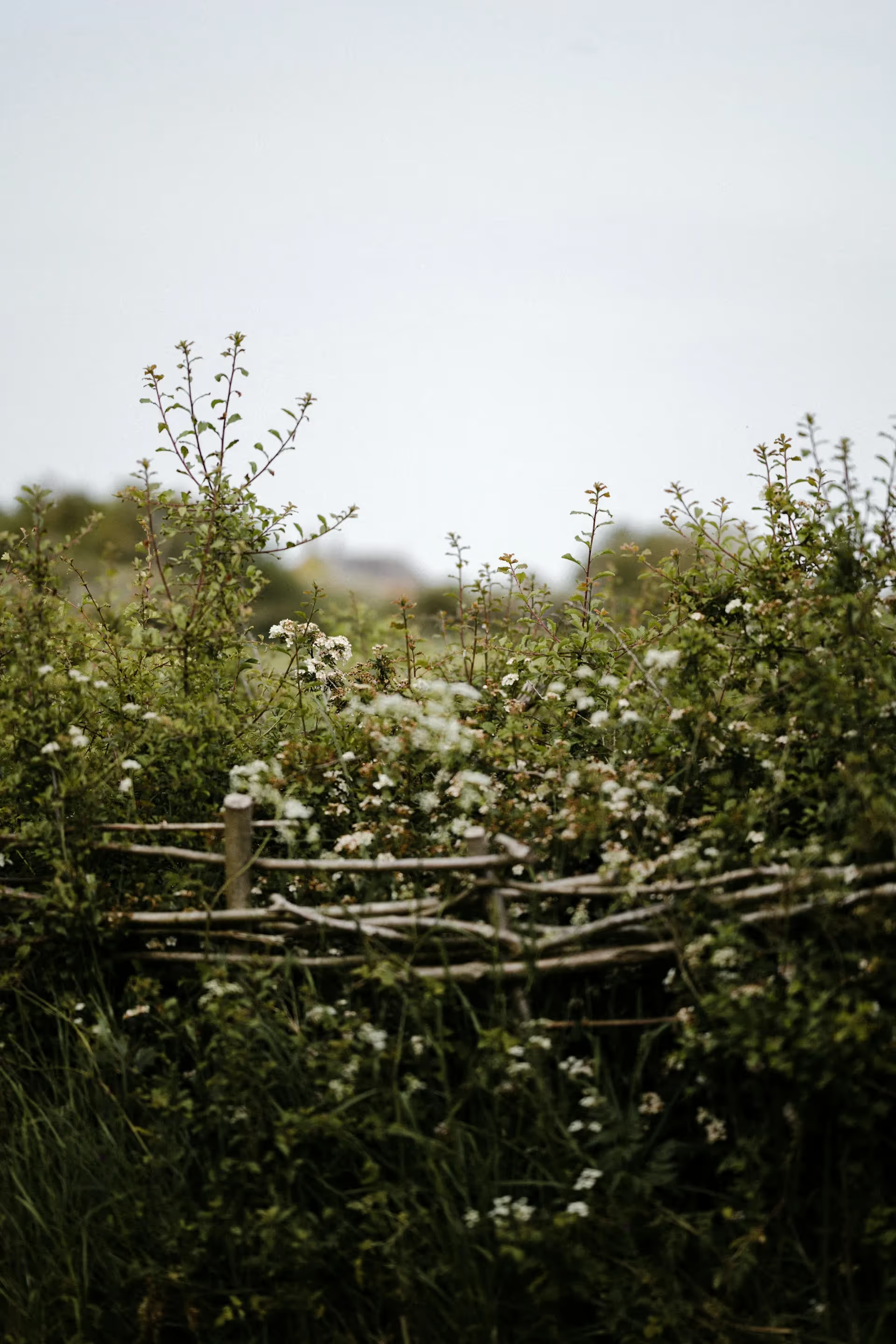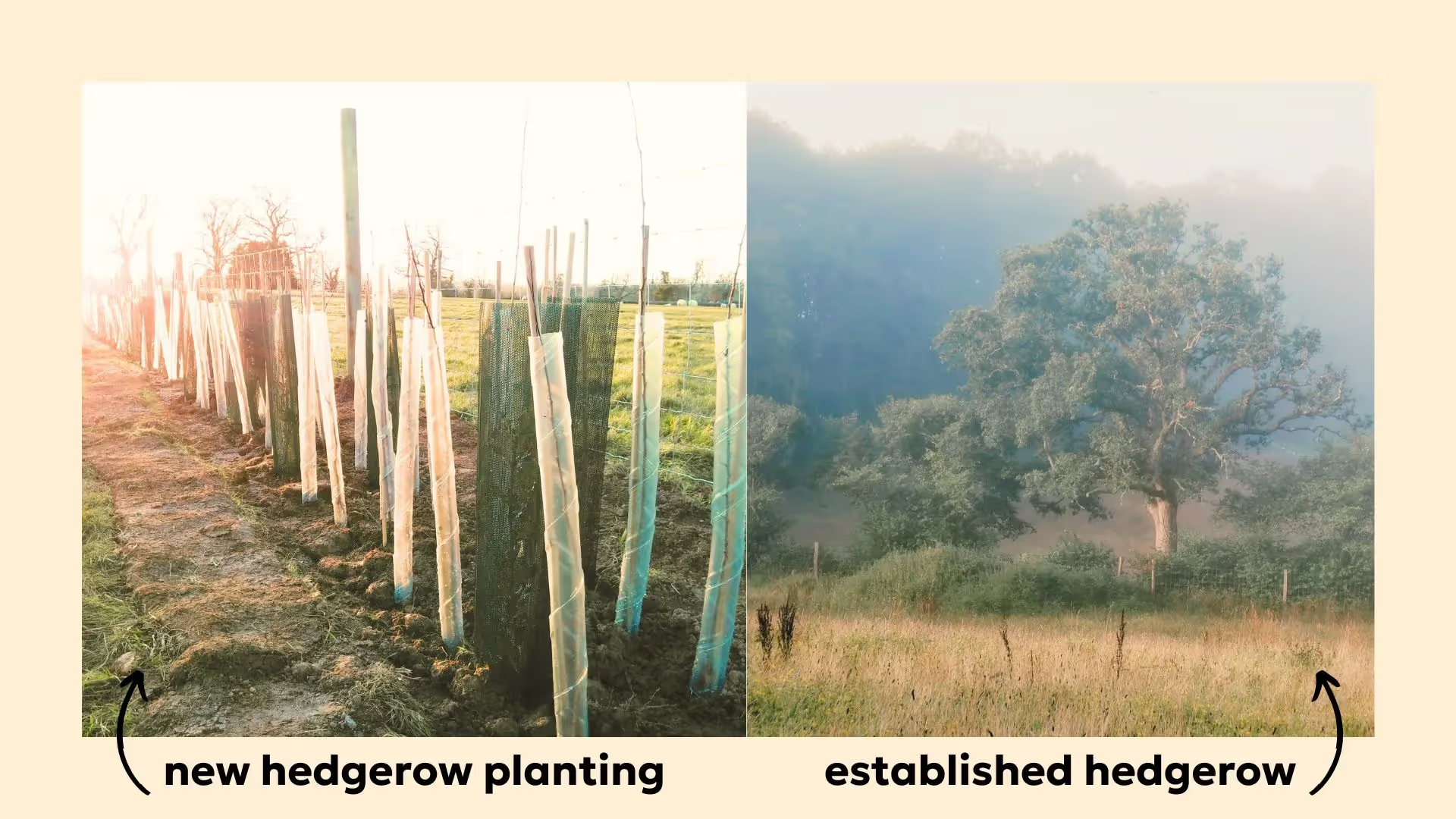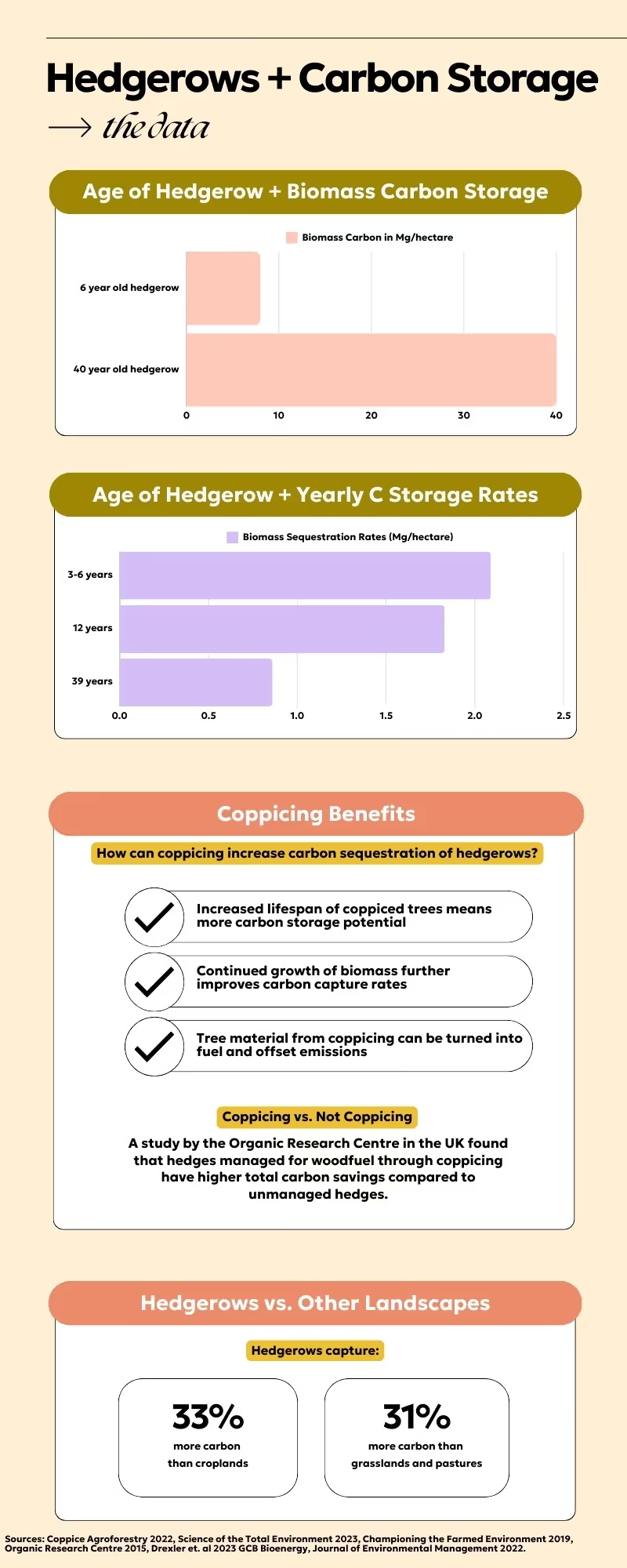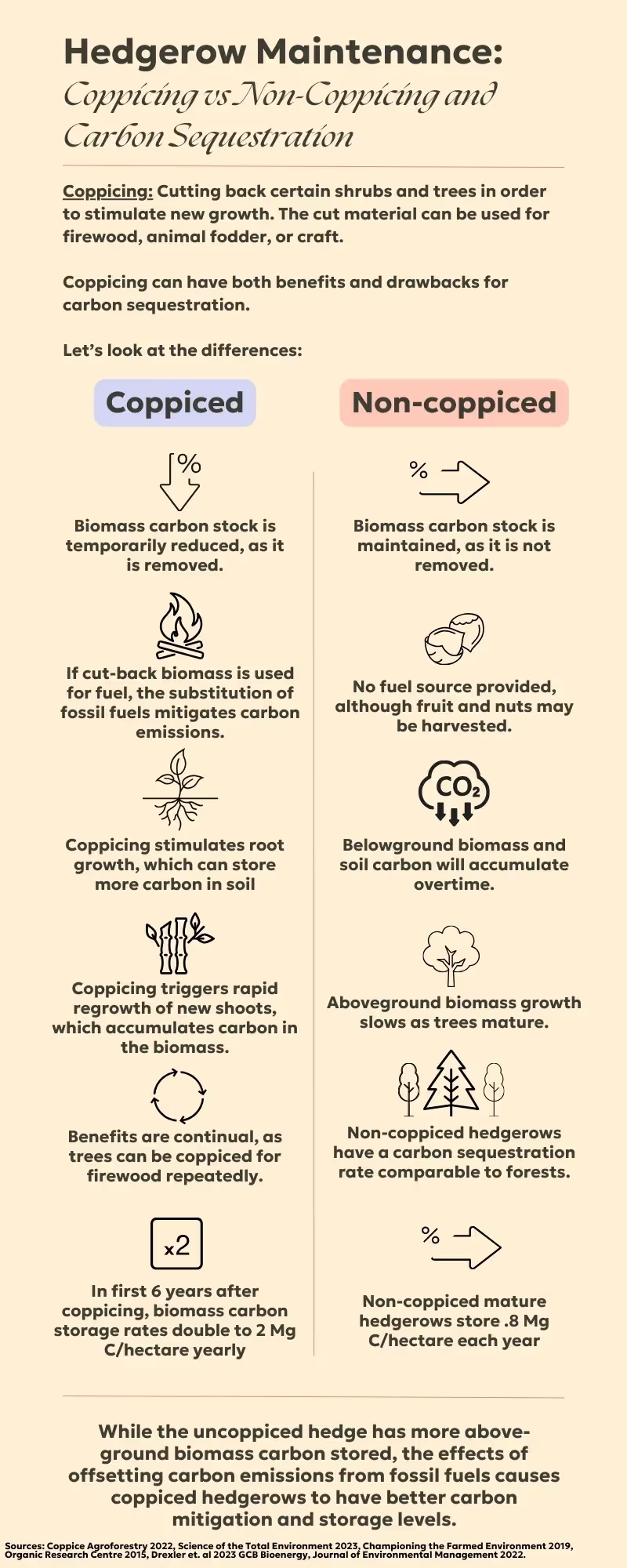
Be a Land Steward.
Sign up for Greenhouse Gases -
a weekly-ish newsletter that will teach you the science behind regenerative gardening, with action steps to help you make a difference in your backyard.

Sign up for Greenhouse Gases -
a weekly-ish newsletter that will teach you the science behind regenerative gardening, with action steps to help you make a difference in your backyard.

I’m continually fascinated by how ancient practices and traditional knowledge show up again and again as solutions to climate change.
As we look into the future for feasible and scientifically-proven ways to mitigate and adapt to climate change, one of the often overlooked methods is one that goes back to the Bronze Age - hedgerows.
At that point in history, hedgerows served practical purposes - a living fence that provided food and other resources for humans and livestock. As a result, wildlife benefits, too.
In my own hedgerow, I often feel a sense of wonder at the web of interactions that occur in this seemingly simple row of trees, shrubs, and plants. Bees and swallowtail butterflies hover in the air, birds play hide-and-seek in the branches and brush, flowers bloom and mushrooms grow.
All the while, this unassuming hedgerow stands as an instrument in the fight against climate change - silently storing carbon dioxide and exhaling life-giving oxygen.
As we learn more about how perennial plantings such as hedgerows have remarkable carbon sequestration potential, we see the ways these structures benefit the soil, atmosphere, and the planet as a whole.
Whether you're a passionate gardener, an environmentalist, or simply someone curious to learn more, this in-depth exploration will leave you inspired to plant your own hedgerow and be part of the nature-based solution.

Glossary:

Through photosynthesis, plants perform a remarkable transformation: they take in carbon dioxide from the air—a gas that plants use like a nutrient—and convert it into solid building blocks for new growth.
This new growth is biomass, which is one way that perennial plants can store carbon.
Any excess carbon is gifted to the microbes that form a relationship with the plants, in exchange for nutrients and water. When these microbes eventually die, the carbon within their bodies contributes to the formation of a rich, dark soil called humus.
Humus acts like a natural storage unit for carbon beneath the ground.
I can see the rich soil that has formed in my own occurring hedgerow. It is rich with organic debris, soft, and loamy. During hot and dry days, it is still cool and slightly damp.
Think of the hedgerow like a bustling city of green skyscrapers. Just as buildings rise high so more people can live in a small area, the dense vertical growth of hedgerows reaches for the sky. This growth allows for leaves, branches, and soil to act like apartments for carbon.
The older the hedgerow, the more carbon they can sequester in both biomass and soil.
A study from 2023 measured biomass carbon stocks in hedgerows that were up to 6 years old. They had around 8 Mg Carbon per hectare - nothing to sneeze at.
But old hedges - they had five times that amount at 40 Mg C per hectare!
While young hedgerows sequester carbon at a faster rate initially, the older hedgerows have had more time to accumulate greater total carbon stocks in their aboveground biomass.
It is important to note that their annual sequestration rate slows as they mature.
Some trees have a naturally long life-span. For example, some species like oak can live for hundreds of years (NYBG).
Want to grow nearly immortal trees? Those tending to hedgerows can increase the age of certain trees through coppicing.
Coppicing is a process of cutting back the tree in a way where it will sprout back from the stump (or stool) that remains.
On our property, we unintentionally coppiced some hazel, cherry, vine maple, willow, and elderberry trees that were decaying. Over the next couple of years, these tree stumps were totally reinvigorated with heaps of new growth. You never would have known that the trees were at one point decaying - they now looked vigorous and alive. Once I learned about coppicing (from Krawczyk’s Coppice Agroforestry), I realized we had unintentionally been coppicing back these trees, and giving them a second life.
This specific method of pruning can increase the life of the tree, while offering a harvest of wood or plant material. All the while, the carbon storage is maintained below ground (Krawczyk, Coppice Agroforestry, 2022).
One stunning example is this linden tree in the UK, which has stood in the same location for up to 2000 years, thanks to a steady coppicing schedule over the millennia.
Coppicing also helps hedgerows to boost their carbon storage potential. This is because the active continual growth prompted by cutting back the trees helps improve the carbon capture rate when compared to the rate of older, non-coppiced hedges (Science of the Total Environment, 2023).
Coppicing doesn't just help trees live longer; it also makes them grow thicker and lusher. This extra growth boosts the hedgerow's ability to store carbon up in its branches and leaves (CFE).
The tree material gathered from the coppice cuts can be turned into fuel, keeping fossil fuels in the ground (CFE, Science of the Total Environment).
When land stewards use the wood harvested from coppiced trees as a source of renewable energy, it helps offset carbon emissions by replacing fossil fuels. This ultimately has a more positive impact on carbon levels than the temporary reduction in plant matter.
A study by the Organic Research Centre in the UK found that hedges managed for woodfuel through coppicing can actually have higher total carbon savings compared to unmanaged hedges.
The Organic Research Centre recommends a 10-15 year coppice rotation cycle. This will help carbon to be stored in biomass between cutting cycles.
However, you can plant 30 trees and coppice 2 new trees a year for firewood fuel to achieve this result.

When compared to grasslands and croplands, hedgerows come through as the carbon storage champ.
Croplands: A study published in 2023 shows that soil under hedgerows store an average of 33% more carbon than adjacent croplands.
Forests: The same study noted that carbon levels in the biomass of hedgerows are similar to that of forests.
Grasslands: Another study in 2022 saw 31% more carbon can be stored in the soil of hedgerows compared to grassland and pasture.
In an informal analysis of the pasture next to my hedgerow, the difference in soil texture and richness is much higher in the hedgerow.
While hedgerows are an ancient practice, they merge well with modern technology to help us understand their various ecosystem services. Cutting-edge remove sensing techniques help us to quantify the benefits of hedgerows over large areas of land.
LiDAR, or Light Detection and Ranging data, helps us to create detailed maps of hedgerows. What’s especially helpful is that this data is in 3D, so scientists can gather information about the heights of different plants in the hedgerows. LiDAR mapping is like giving scientists X-ray vision, allowing them to see the hidden structure and potential of our nation's hedgerows (Ecology Evolution).
In January of 2024, the UK Centre for Ecology and Hydrology recently utilized the LiDAR maps to create the most comprehensive map of hedgerows in the UK to date (phys.org).
The information provided by the LiDAR maps helps scientists to estimate carbon sequestration potential and identify areas that need maintenance in order to optimize environmental benefit (Ecology Evolution).
The University of Hull got some help from AI to identify hedgerow gaps across the UK. This provided data on prime locations for targeted tree planting and hedgerow restoration to maximize carbon sequestration.
Hedgerows accomplish a lot in a small amount of space, which is great news for those living in urban and suburban areas.
Not only do hedgerows provide an opportunity to sequester carbon, but they also improve air quality and provide an urban cooling effect (Urban Forestry + Urban Greening).

When it comes to designing a hedgerow for maximum carbon sequestration, the plant species you choose are crucial. Focus on native trees, shrubs, and groundcover.
Native species will be a food source for local wildlife, and typically are easier to maintain.
In the same way that regenerative farmers shy away from monocropping and instead focus on diverse crop plantings, hedgerows provide richer environmental benefits when filled with an array of species.
A study in British Columbia, Canada found that planted hedgerows robust in species richness and diversity indices stored significantly more soil carbon.
There are a few different reasons why this happens:
(Mycorrhizae 2022, Journal of Soil and Water Conservation 2015).
Apply these findings to your own hedgerow by planting a wide variety of native trees. Mix native fruit and nut trees with locally adapted evergreen species, and plant early nectar sources like willow to support pollinators. Look into which native trees are best for coppiced firewood in your region, if you are able to heat your home with a wood stove.
Hedgerows are a simple, nature-based solution with the power to make a significant impact in the fight against climate change. By quantifying their remarkable carbon sequestration potential, I hope this article has inspired you to consider planting your own hedgerow - a living, breathing testament to the transformative power of working with nature.
Together, we can harness the full potential of these unsung heroes and create a greener, more sustainable future.